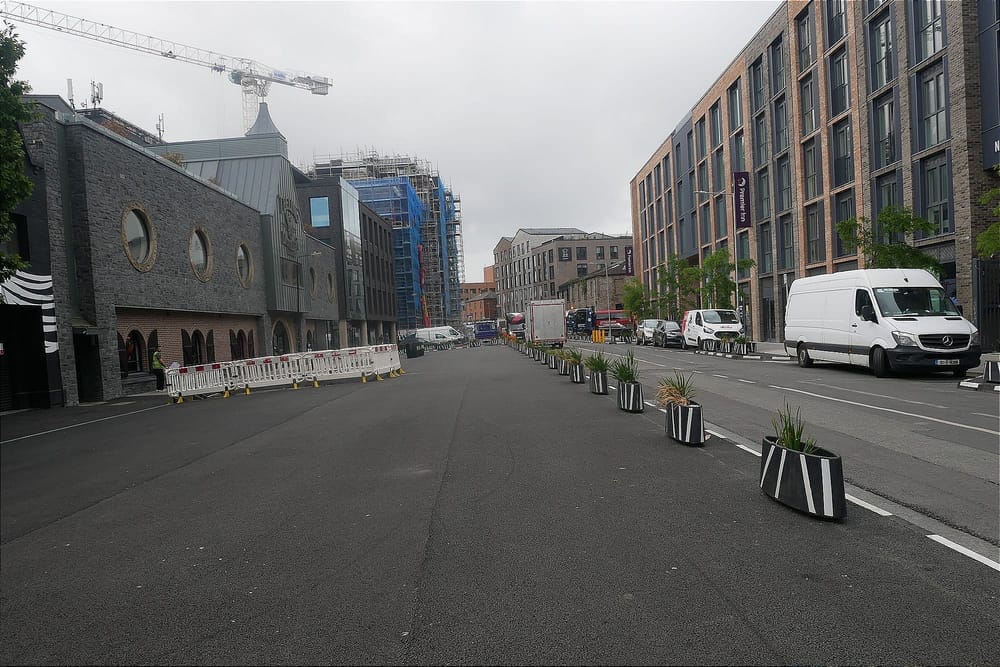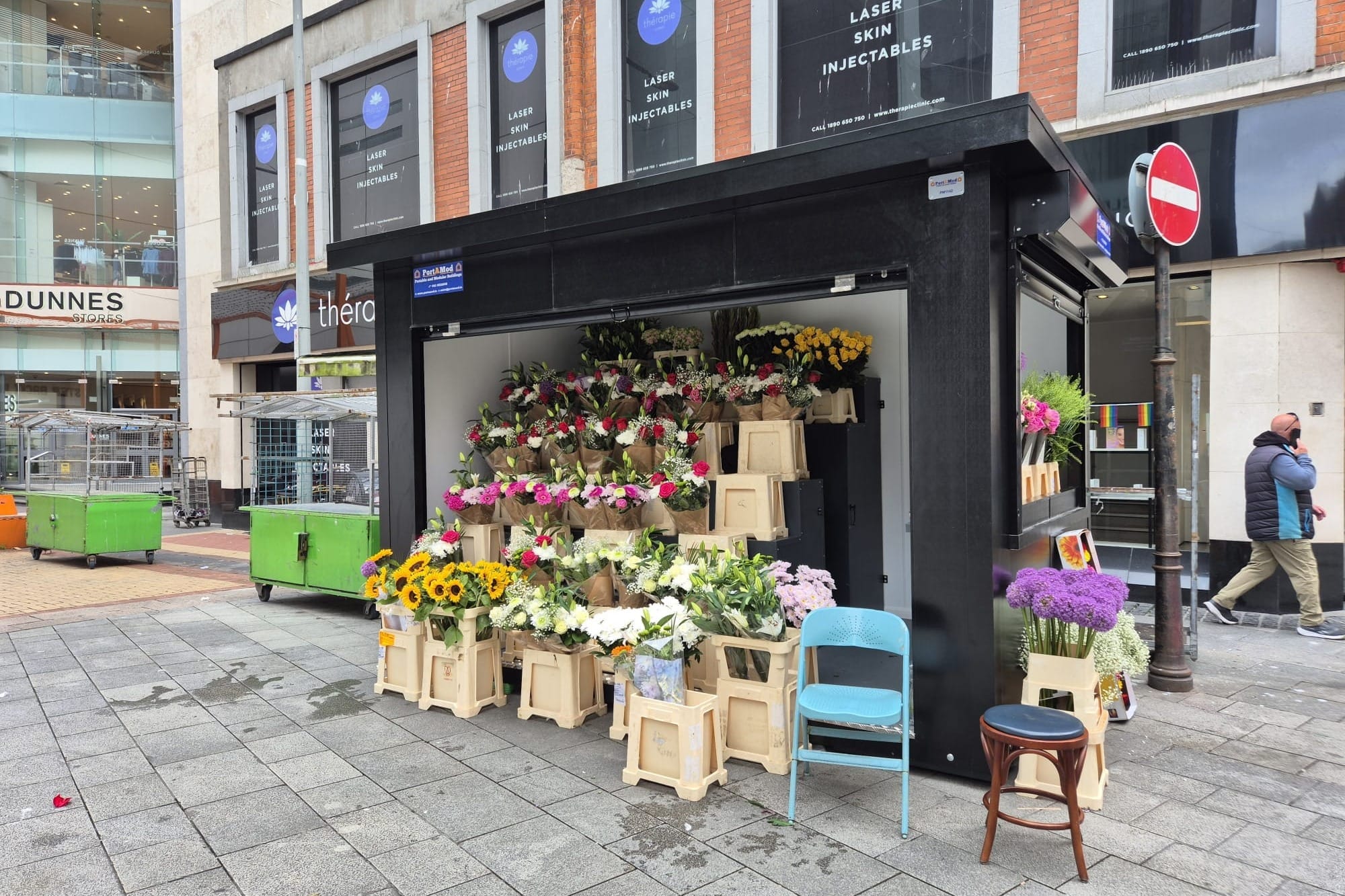In Ballymun, lining up to read and reconnect with the constitution
“Some people have said it's a bit like karaoke.”
Draft bye-laws, due soon to go out to public consultation, suggest adding some new market areas and shrinking some oldies.

Dublin City Council has put forward proposals to change where street markets and stalls trade in the city – with some areas taken off the list, and other new spots added.
The changes to the city’s casual trading bye-laws are needed to support outdoor city life, said David Forde, manager of the City Co-ordination Office, at a council meeting on Tuesday.
They also need to ensure modern and legally compliant trading, vibrant and safe street markets – and realign with commercial patterns and what city-dwellers want, he said.
The current bye-laws date to 2013, Forde told members of the council’s Planning and Urban Regeneration Strategic Policy Committee.
But the Covid-19 pandemic brought more of a shift towards outdoor living, said Forde, so the council has looked at expanding some of the spaces already in use and adding new ones.
“Public realm projects and enhancing the city's adaptability have changed how we actually look at what's being used outside in the public domain”, he says.
Changes are planned for the city’s oldest outdoor market, Moore Street. New additions are also suggested – like stalls at Portobello Harbour and Foster Place.
Most of the trading areas, or “pitches”, that are listed to be dropped, seem to be either because of a lack of space, or a lack of interest from traders, according to a document shared with councillors.
Areas that would be de-designated include Heuston Station, which is no longer viable due to a road realignment, and Store Street, because it is so close to the Luas line, the document says.
Also, pitches on Coppinger Row should be dropped because of a lack of space and on Erne Street/Pearse Street, due to lack of interest from traders, it says.
Wolfe Tone Park and Ranelagh Triangle would also be “de-designated”, with exceptions for “special themed markets”, that could run from time to time, it says.
Trial runs for market stalls at the Ranelagh Triangle were unsuccessful, the document says. Wolfe Tone Park should be de-designated because it falls under the remit of the Parks Department, it says.
The draft bye-laws say the top of Grafton Street should be de-designated as it’s used by buskers as a performance area, under the Street Performers Bye-Laws.
While it's proposed that Middle Abbey Street would be de-designated over health and safety concerns because of how close the pitches are to the Luas, those pitches would be moved to O’Connell Street.
Christmas market trading dates for Henry Street and Mary Street are to be changed from 1–31 December, to 24 November–24 December, 10am til 9pm. Although these dates remain subject to change, the proposal says.
At the meeting, Social Democrats Councillor Catherine Stocker, the chair of the committee, said she welcomed the suggestion of market spaces on Portobello Harbour.
The harbour had been the site of some controversy over the last few years, she said.
Portobello Harbour would be allocated two pitches for tea/coffee and light snacks, under the current proposal.
Dermot Lacey, a Labour councillor, said that while he doesn’t represent the area, he thinks local representatives would love to see work on the redesign of Portobello Harbour finished.
“That would be a good start. It’s been a long time coming,” Lacey said.
As well as the two regular pitches, Portobello Harbour is listed among the sites where special themed markets should be allowed. Alongside: Moore Street, Thorncastle Street, College Green, and Newmarket.
Newmarket is on the list, with stalls allowed that offer “jewellery, fashion accessories, souvenirs and crafts”, it says.
It doesn’t say how many pitches. But traders have been calling for a return to markets on the square, once interim works have been finished to improve the space.
Stephen Coyne, an economic development officer with the council, has said the council is hoping to host some events and markets on the square over the summer.

Other new spots for trading include Foster Place, off College Green, which would host three pitches for tea/coffee/snacks, flowers, jewellery and fashion accessories, it says.
While trading times for art sellers on three sides of Merrion Square are to be extended to include Friday evenings and bank holidays, Merrion Square South is marked as a new designation.
It would also be allocated for the selling of paintings and drawings, which must be the licence holder’s own original work, or reproductions of their own original work.
Temple Bar Square would get a new designation, with possible stalls to offer fruit and vegetables, confectionery, jewellery, fashion accessories, souvenirs and crafts.
And, the proposal would also formalise the existing food market on Meeting House Square and Curved Street, with 23 pitches allocated.
Missing from the list is the Broadstone Plaza, which two years back, councillors for the area had campaigned to see animated. But that didn’t come up at the planning committee.

The iconic Moore Street, Dublin’s oldest outdoor market and home to traders since the 18th century, would see changes under the draft bye-laws.
The current allocation of 69 pitches would be cut down to 40.
The council’s management of the market’s pitches has been a contentious issue in the past, when it stopped issuing new licences while the street’s stalled development was being discussed.
The reduction to 40 pitches is not due to a lack of interest, says Forde, the council manager, but because the stalls are bigger than the last time the bye-laws were updated.
The draft by-laws say the famous trading street would also be the site of a new evening market. That’s in keeping with Dublin’s night-time economy strategy.
The later affair would include mobile food trailers, as well as opportunities for those selling jewellery, and crafts.
The council is making an effort to diversify trading in the area, says Forde.
Traditional stalls with fruit, and vegetables and flowers need to be supported, he says, but people are looking for variety too.
Traders will be expected to use stalls approved by the council and maintain them, the bye-laws say.
There is also a proposal to standardise trading times across the city, and to include Sundays and Thursday late-night shopping.
But one thing that won’t change are the fees – for now, at least.
“I think one or two cases, we've actually reduced fees due to the lack of uptake on some of the pitches,” says Forde.
Street trading is part of the lifeblood of Dublin, he says, and must be encouraged.
“If we started with a fee increase, we might knock people away from coming. So that's part of our rationale,” he said.
Lacey, the Labour councillor, said he is largely supportive of what he sees in the new bye-laws for street trading in the capital.
But he would like to see a bit more flexibility, he said by phone on Thursday.
Take Lansdowne Road, where on match days at the Aviva Stadium, traders set up in the same place they have done for years at the top of the road – where it joins with Pembroke Road.
Fewer people used to live there when trading began, Lacey says. There are more homes now, he says.
Traders could easily be moved to a less populated spot near the old Jurys Hotel, he says.
“At seven and a half million an apartment, I don’t think there’s much of a vote for me there, but I’d still like to help them if I can,” Lacey said, through a chuckle, at Tuesday’s committee meeting.
Lacey says there’s a need for future legislation so council officials can move traders from one spot to another on the same road without a big rigamarole.
Sebastian Vencken, a representative of the Broadstone Basin Residents Association and a member of the committee, said he would like to see streets closed for a day for larger markets, where people can roam freely, as in New York or Rome.
Grattan Bridge would be a great candidate to close off, he said, at the meeting. “And then have a market there on the bridge in a visible location like that, instead of tucked away in hidden squares.”
Forde said this could be done as a one-off without putting it in the bye-laws. “We're doing the same on Parliament Street for the summer.”
The next step in the plan to revamp the trading bye-laws – following approval from members of the planning committee – is to bring a report to the council to initiate public consultation, said Forde.
That would run for two months. Officials then consider submissions and make any changes – and put a final version before the full council to vote on.
Funded by the Local Democracy Reporting Scheme.